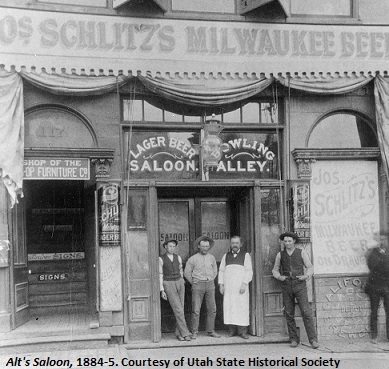Dublin Core
Title
Description
The surprisingly stout and spirited history of the liquor industry in 19th century Utah!
During the late 1800s, Utah had a thriving liquor industry. LDS Church President Brigham Young had no qualms about producing or selling alcohol. He built a distillery at the mouth of Parley’s Canyon and owned Salt Lake City’s first saloon. In 1861, Young had a winery established in Toquerville, in southern Utah, and received frequent shipments of 40-gallon barrels of port for “medicinal and family use.” The Mormon-owned mercantile ZCMI sold beer, wine and liquor, while the Deseret News regularly advertised home-brewing equipment to its readers, as well as alcohol such as Kentucky Bourbon and Old Tom Gin.
Mormons also produced their own brand of whiskey, called “Valley Tan.” This paralyzing intoxicant was reputed to have quite a punch, and was known variously as leopard sweat, liquid strychnine, and tarantula juice. Valley Tan was served in Salt Lake’s numerous downtown saloons, which were frequented by US soldiers who came with Johnston’s Army in 1858. The troops spurred such a trade in alcohol that Salt Lake’s Main Street soon earned the nickname “Whiskey Street.”
Utah was also home to fifteen commercial breweries, several of which were owned by faithful members of the Mormon Church. For example, Brigham Young’s bodyguard Orrin Porter Rockwell owned the Hot Springs Brewery at the Point of the Mountain. Beer was consumed by many Mormon immigrants from Europe, as well as Germans, Italians, and Irishmen who came to work in the Utah mines.
Liquor was big business. In 1863, the Salt Lake City government reported more revenue from the liquor industry than all city taxes combined. By 1871, a liquor license in Salt Lake cost $750 per month, as compared to $56 per year in Chicago. But profits were not enough to stem the tide of temperance sweeping the state. By the turn of the century, attitudes about alcohol were changing and Utah prohibition was just around the corner.
Creator
Source
Image: Alt's Saloon. Jacob Alt's Saloon, located at 109 South Main Street, c. 1884-5. Courtesy of Utah State Historical Society.
_______________
See Linda Sillitoe, A History of Salt Lake County, Salt Lake City: Utah State Historical Society, 1996, pp. 46-132; Jan Shipps, “Utah Comes of Age Politically: a Study of the State's Politics in the Early Years of the Twentieth Century,” Utah Historical Quarterly, Volume 35, Number 2, Spring 1967, pp. 91-111; Hal Schindler, Salt Lake Tribune, 11/20/1994 and 9/17/1995; Fawn Brodie, “Sir Richard F. Burton: Exceptional Observer of the Mormon Scene,” Utah Historical Quarterly, Volume 38, Number 4, Fall 1970, pp. 295-311; Will Bagley, “Early Utah Saw No Evil in Liquor Ads,” Salt Lake Tribune, 11/4/2001; Del Vance, Beer in the Beehive: A History of Brewing in Utah, Salt Lake City: Dream Garden Press, 2008.

